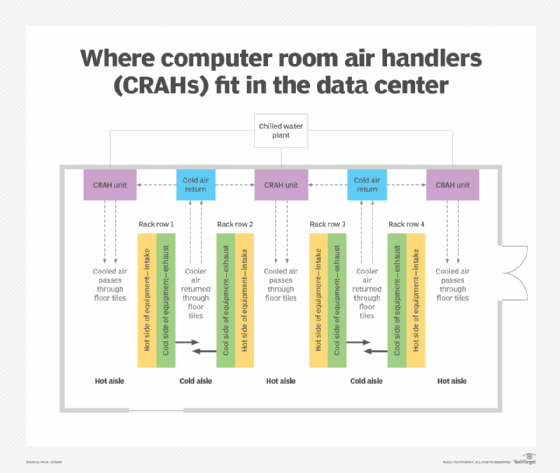computer room air handler (CRAH)
What is a computer room air handler (CRAH)?
A computer room air handler (CRAH) is a device frequently used in data centers to deal with the heat produced by equipment. Unlike a computer room air conditioning (CRAC) unit that uses mechanical refrigeration to cool the air in a data center, a CRAH uses fans, cooling coils and a water chiller system to remove heat.
A typical rack of servers can generate temperatures up to 100 degrees Fahrenheit. However, data centers and other computer facilities must maintain an environment of about 68 degrees Fahrenheit and relative humidity around 50%. Computer room environmental systems, specifically heating, ventilation and air conditioning (HVAC) systems, must maintain an environment within acceptable ranges for temperature and humidity. Not doing so can cause systems to fail or shut down.
CRAH vs. CRAC: Which is better in your data center?
CRAHs use chilled water in a cooling coil and a fan by blowing air over the coil to generate cooled air. By contrast, CRAC systems use refrigerant and a compressor, similar to a regular air conditioner used in homes. They blow air over a cooling coil filled with refrigerant.
Both systems use raised floors for data center cooling. Raised floors circulate cool air under the floor through perforated floor tiles to ensure adequate air distribution. They also allow warm air from equipment to cycle to the computer room air handling units.
Computer room air conditioners can be self-contained, whereas CRAH systems require chilled water and under floor plumbing to feed water to the CRAH units. Both systems are effective as part of an HVAC layout.

CRAH and CRAC system planning considerations
When building a new data center or upgrading the HVAC systems in an existing one, the following eight steps should be part of the planning process:
- Evaluate the performance and energy efficiency of existing systems.
- Identify areas that need to be remedied because of problems such as fluctuating temperatures and thermostats not working properly.
- Work with experienced HVAC engineers to design the new or revised configuration of the HVAC system.
- HVAC engineers must determine the most effective location for a chilled water plant.
- Work with vendors experienced in data center environment planning and design. This is especially important when configuring underfloor air flow and water pipes for CRAH systems.
- Build an HVAC plant capable of handling current and future needs in areas such as cooling capacity.
- Implement backup arrangements so that primary CRAH or CRAC units will have backups available in an emergency.
- Ensure that power systems are configured to support uninterrupted operation of HVAC systems.
Energy-efficient updates to CRAH systems
Data center air cooling and heating systems have changed a lot in the last decade, simplifying maintenance and increasing efficiency. Today's CRAH and CRAC systems can be programmed to establish and maintain a suitable environment, providing data center energy savings and efficient cooling systems.
The following are among the more recent equipment upgrades and data center best practices:
- Motors and fans. Electronically commutated motors are smaller and have variable speeds, optimizing data center airflow and cooling.
- Cleaning and filtering. Improved data center cleaning and filtering has cut dust and dirt buildup that can harm equipment.
- Sensor use. Increased use of sensors and improved sensors provide more and better data to track issues and assess causes.
- Humidity guidance. Changes in recommendations for data center humidity levels have decreased the need for internal humidifiers in CRAH systems. Standalone ultrasonic units are more commonly used.
Learn more about recent data center design upgrades that are changing the systems used to heat and cool them.






